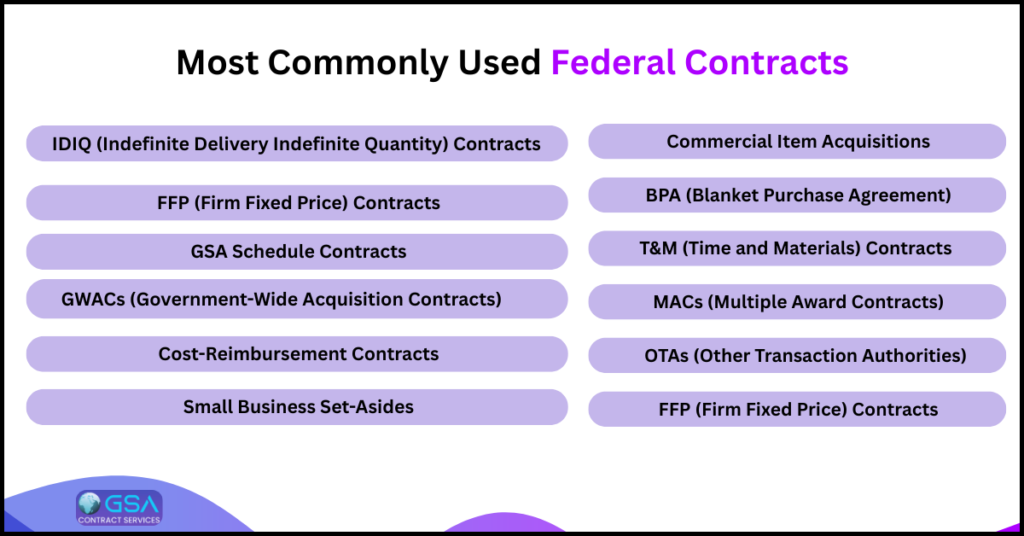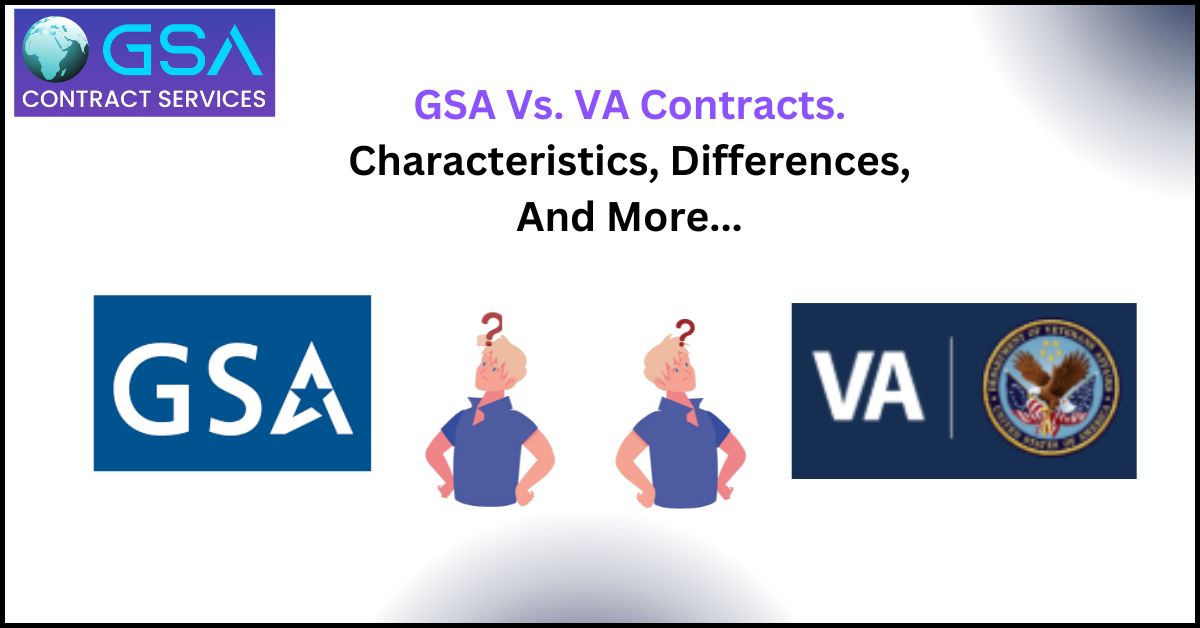Federal agencies use several types of contracts to buy products and services from businesses. Each type of contract serves a specific purpose based on the agency’s needs, budget, and timeline. If you are looking to sell to the government, understanding these contract types is key.
This guide will break down the most common types of federal contracts with their short summaries and some key advantages. Some of these contracts include:
- IDIQ (Indefinite Delivery Indefinite Quantity) Contracts
- BPA (Blanket Purchase Agreement)
- FFP (Firm Fixed Price) Contracts
- T&M (Time and Materials) Contracts
- GSA Schedule Contracts
- MACs (Multiple Award Contracts)
- GWACs (Government-Wide Acquisition Contracts)
- OTAs (Other Transaction Authorities)
- Cost-Reimbursement Contracts
- Commercial Item Acquisitions
- Small Business Set-Asides
Each contract type works differently and comes with its own rules, benefits, and challenges.
Indefinite Delivery Indefinite Quantity (IDIQ) Contracts
IDIQ contracts are used when the exact quantity and timing of supplies or services are not known in advance.
- These contracts define a minimum and maximum quantity.
- Agencies issue task or delivery orders when they need the item or service.
- They allow flexibility and are ideal for long-term needs.
IDIQs are commonly used by the Department of Defense, NASA, and the General Services Administration (GSA). One famous example is the Encore III contract by the Defense Information Systems Agency (DISA), which is an IDIQ valued at $17.5 billion.
IDIQs are also suitable for repetitive services like maintenance, IT support, or facilities management. By using this format, agencies avoid delays and ensure ongoing work without rebidding.
Key Advantages:
- Reduces the need for multiple procurements
- Offers flexibility to the government and vendors
- Allows for competition at the task order level
- Promotes long-term engagement between the vendor and the agency
More Info on: IDIQ Contracts – Acquisition.gov
Blanket Purchase Agreements (BPAs)
BPAs are used for recurring needs. Agencies set up BPAs with vendors they trust, then order supplies or services as needed without negotiating every time.
- No guaranteed orders, but vendors benefit from repeat business
- Agencies can create single or multiple-award BPAs
- BPAs work well for items bought frequently, like office supplies, IT services, and training.g
BPAs are highly favored by procurement officers because they provide administrative savings. Pricing can be pre-negotiated, and ordering procedures can be customized.
Key Advantages:
- Fast ordering process
- Reduces paperwork
- Encourages long-term vendor relationships
- Can be built off existing GSA contracts
More Info on: Blanket Purchase Agreements – GSA.gov
Firm Fixed Price (FFP) Contracts
FFP contracts are the simplest type. The price is set upfront and does not change regardless of the cost the vendor incurs.
- Ideal for products or services with a clear scope and cost
- Reduces risk for the government
- Vendor takes on the cost risk
These contracts are often used for construction, IT products, and other clearly defined services. When the scope is well-understood, these contracts offer predictability.
Key Advantages:
- Budget certainty for agencies
- Simple to manage
- No need for detailed cost tracking
Risks for vendors:
- Cost overruns are not reimbursed
- Delays and scope creep can affect profitability
More Info on: FTP Contracts – Acquisition.gov
Time And Materials (T&M) Contracts
T&M contracts are used when it is difficult to estimate the time or materials required to complete a task.
- Agencies pay for labor hours at a fixed rate plus the cost of materials
- Often used for short-term, specialized services
- High risk if not closely managed
These contracts require strong oversight to avoid unnecessary costs. Government auditors frequently review T&M contracts to ensure accountability.
Key Features:
- Requires oversight and time tracking
- Flexible but prone to cost growth
- Allows for change as the project evolves
More Info on: Time And Materials (T&M) Contracts – Acquisition.gov
GSA Schedules (Multiple Award Schedules)
GSA Schedules are long-term government-wide contracts for commercial products and services.
- Contracts last up to 20 years (5-year base, three 5-year options)
- Vendors must meet strict compliance and pricing standards
- Used by all federal agencies
There are over 12 million products and services available through GSA Schedules. More than $40 billion is spent annually through this program.
Key Benefits:
- Fast, streamlined procurement
- Pre-negotiated pricing
- Compliance with federal rules is already built in
- Competitive opportunities for small and large businesses
Popular schedules include:
- Schedule 70 (IT Services)
- Schedule 84 (Security)
- Schedule 56 (Buildings and Industrial Supplies)
Recommended: What Are GSA Contracts?
Multiple Award Contracts (MACs)
MACs are contracts awarded to multiple vendors for the same or similar services or products.
- Encourages competition at the task order level
- Can be IDIQs or other formats
- Often used for large-scale federal projects
MACs are essential for supporting large programs where no single vendor can meet all needs. This structure also allows agencies to access a variety of solutions.
The MACs are different from the Multiple Award Schedule contract for the GSA in terms of scope and agency affiliation.
While the GSA MAS contracts are governed and managed by the GSA and are the Schedule contracts, the MAC contracts are more broadly defined as contracts that can be used by any number or type of agency or different types of contracts, as opposed to the schedule contracts from the GSA.
Key Features:
- Increases vendor participation
- Supports faster procurement cycles
- Agencies can issue task orders based on best value or lowest price
More Info on: Multiple Award Contracts – Acquisition.gov
Government-Wide Acquisition Contracts (GWACs)
GWACs are MACs that can be used by any federal agency.
- Managed by executive agencies like GSA, NASA, or NIH
- Focus on IT solutions and services
- Includes contracts like Alliant 2, CIO-SP3, and SEWP V
These contracts are ideal for IT modernization, cloud services, cybersecurity, and enterprise infrastructure.
Benefits:
- Pre-competed, easy to use
- Ideal for IT modernization
- Includes small business set-asides
- Cost-effective for government buyers
More Info on: Government-Wide Acquisition Contracts – GSA.gov

Other Transaction Authorities (OTAs)
OTAs are not traditional contracts, grants, or cooperative agreements. They are used mostly for research, development, and prototyping.
- Not subject to FAR regulations
- Used by NIH, DOD, NASA, DHS, and other agencies
- Encourages innovation and collaboration
Agencies can negotiate unique terms, which allows more flexibility and less red tape. OTAs are commonly used in projects related to artificial intelligence, biotechnology, and advanced manufacturing.
Key Advantages:
- Faster and more flexible than traditional contracts
- Ideal for new technologies
- Less red tape for both sides
- Encourages non-traditional companies to participate
More Info on: Other Transaction Authorities – NIH.gov
Task And Delivery Order Contracts
These are often a component of IDIQs. They allow agencies to issue specific orders for services or goods under the umbrella of a larger contract.
- Task orders are for services.
- Delivery orders are for goods.
- Streamlines repeat purchases
Agencies benefit from a reduced administrative burden. Vendors benefit by being eligible to receive multiple assignments without rebidding each time.
More Info on: Task And Delivery Order Contracts – Acquisition.gov
Cost Reimbursement Contracts
In cost reimbursement contracts, the government agrees to cover the allowable costs a contractor incurs.
- Used when there is uncertainty about project scope or cost
- May include incentive or award fees
- Ideal for R&D and complex technical work
These contracts require contractors to establish robust accounting systems. There is more government oversight, and invoices are reviewed closely for compliance.
Types include:
- Cost Plus Fixed Fee (CPFF)
- Cost Plus Incentive Fee (CPIF)
- Cost Plus Award Fee (CPAF)
Drawbacks:
- Higher risk for the government
- Requires detailed cost tracking and oversight
More Info on: Cost Reimbursement Contracts – Acquisition.gov
Commercial Item Contracts
These contracts are used to acquire items that are already sold to the public.
- Based on market pricing
- Used when FAR Part 12 applies
- Simplifies the acquisition process
Examples include off-the-shelf software, standard hardware, and commercial training courses. This method leverages commercial competition and efficiency.
More Info on: Commercial Item Contracts – Acquisition.gov
Small Business Set-Asides
These contracts are reserved for small businesses under SBA guidelines.
- Includes 8(a), HUBZone, Women-Owned, and Service-Disabled Veteran-Owned programs
- Helps meet federal small business goals
- Encourages competition and economic growth
These set-asides increase access for underrepresented businesses. Agencies are evaluated based on how well they meet their small business contracting goals.
In FY2023:
- 26.5 percent of all federal contract dollars went to small businesses
- SBA exceeded its 23 percent goal
More Info on: Small Business Set Asides – SAM.gov
Choosing the Right Contract Type
Federal buyers choose a contract type based on:
- Scope clarity
- Timeframe
- Budget limits
- Risk tolerance
- Market availability
Vendors should align their capabilities with the appropriate contract type to increase their chances of success. Knowing how each works also helps when subcontracting.
Summary
Federal contracting is full of acronyms and rules, but each contract type has a purpose. Whether it is the flexibility of an IDIQ, the convenience of a BPA, or the certainty of a firm fixed price agreement, these contracts are how the government does business.
Understanding them is your first step to doing business with the federal government successfully. Keep learning, stay compliant, and use the right resources to increase your chances of winning.



